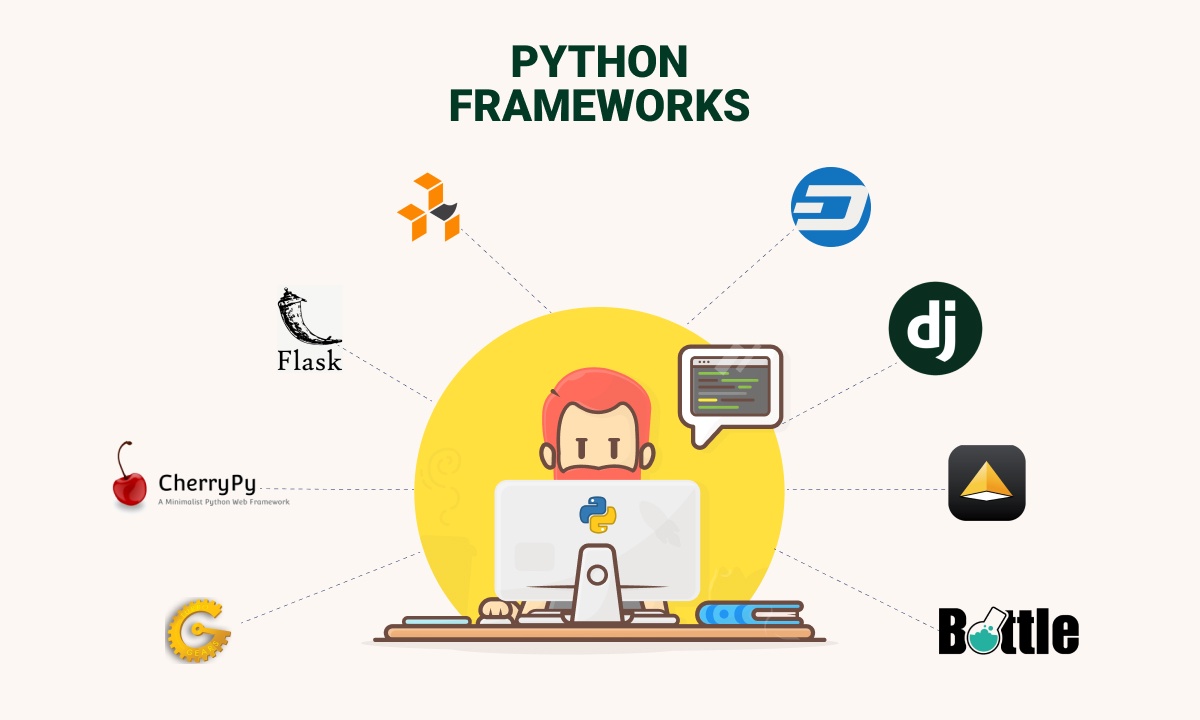What is a Python Development Framework?
A Python web framework is a collection of libraries and tools that provide developers with a structure for building web applications. These frameworks streamline the process of web development by providing pre-built components and enforcing certain conventions, which help in organizing code, handling common tasks, and promoting best practices.
When to use a development framework?
These are some of the scenarios where it is helpful to use a python development framework.
Rapid Development: When you need to develop a web application quickly, frameworks provide pre-built components, templates, and conventions that streamline development, allowing you to focus on implementing business logic rather than reinventing the wheel.
Scalability: Scalable solution is often the answer to most of the small to medium size businesses. Frameworks often come with built-in features and best practices for scaling applications. They provide structures for organizing code, handling database interactions, and managing application architecture, which can facilitate scalability as your application grows. Along with a framework with best practices for scaling, a highly available hosting service is also required for such applications.
Maintainability: Frameworks enforce coding standards, conventions, and design patterns that promote clean, maintainable code. This makes it easier for developers to understand and maintain the codebase over time, especially when multiple developers are working on the project.
Security: Many frameworks include built-in security features and protections against common web vulnerabilities, such as SQL injection, cross-site scripting (XSS), and cross-site request forgery (CSRF). By using a framework, you can leverage these security measures to help protect your application from attacks.
Community and Ecosystem: Frameworks typically have large and active communities of developers who contribute libraries, plugins, and extensions that extend the functionality of the framework. Leveraging these community resources can save development time and effort.
**Flexibility: **While frameworks provide conventions and best practices, they also offer flexibility to customize and extend the framework to meet the specific needs of your application. This allows you to leverage the benefits of a framework while still accommodating unique requirements.
Documentation and Support: Frameworks often come with extensive documentation, tutorials, and support resources that help developers get started and troubleshoot issues. This can be particularly valuable for beginners or teams working on complex projects.
Top Web Development frameworks for python
Django:
Functionality and Features: Django is a high-level web framework that follows the Model-View-Template (MVT) architectural pattern. It provides a robust set of features including ORM, authentication, URL routing, template engine, admin interface, and more.
Pros:
Rapid development: Django’s built-in features and conventions enable developers to build web applications quickly.
Security: Django comes with built-in protection against many common security threats.
Scalability: Django is designed to scale, making it suitable for large and complex applications.
Cons:
Learning curve: Django has a steep learning curve for beginners due to its comprehensive nature.
Pricing: Django is an open-source framework released under the BSD license, so it’s free to use.
Learn more about this framework through and in-depth comparison between nodejs vs Django.
Flask:
Functionality and Features: Flask is a lightweight and flexible web framework that follows the WSGI (Web Server Gateway Interface) specification. It provides essential features for web development such as URL routing, template engine, and session management, but allows developers to add extensions for additional functionality.
Pros:
Lightweight: Flask is minimalistic and doesn’t impose any specific libraries or tools, giving developers more flexibility.
Easy to get started: Flask’s simplicity makes it easy for beginners to get started with web development.
Cons:
Less built-in functionality: Flask provides fewer built-in features compared to Django, requiring developers to rely on third-party extensions for additional functionality.
Pricing: Flask is open-source and free to use.
FastAPI:
Functionality and Features: FastAPI is a modern web framework for building APIs with Python. It is based on standard Python type hints for defining API schemas and leverages the ASGI (Asynchronous Server Gateway Interface) specification for high performance.
Pros:
High performance: FastAPI is designed for high performance, making it suitable for building fast and scalable APIs.
Automatic documentation: FastAPI generates interactive API documentation automatically from the code, making it easy to understand and test APIs.
Cons:
Limited support for web applications: FastAPI is primarily focused on building APIs, so it may not be the best choice for building full-fledged web applications.
Pricing: FastAPI is open-source and free to use.
Tornado:
Functionality and Features: Tornado is a scalable, non-blocking web server and web application framework. It is well-suited for building real-time web applications such as chat applications and long-polling servers.
Pros:
Asynchronous I/O: Tornado’s asynchronous design allows it to handle thousands of simultaneous connections efficiently.
Web server and framework combined: Tornado includes both a web server and a web framework, making it a suitable choice for building asynchronous web applications.
Cons:
Steeper learning curve: Tornado’s asynchronous programming model can be challenging for developers who are not familiar with asynchronous programming.
Pricing: Tornado is open-source and free to use.
Each of these frameworks has its own strengths and weaknesses, so the choice depends on the specific requirements and preferences of the project.


No comments yet